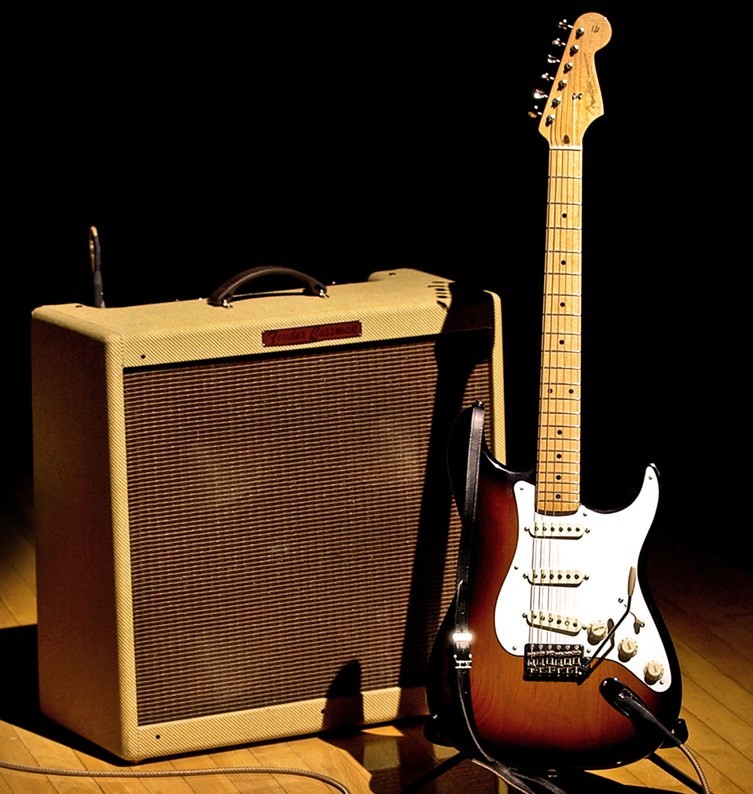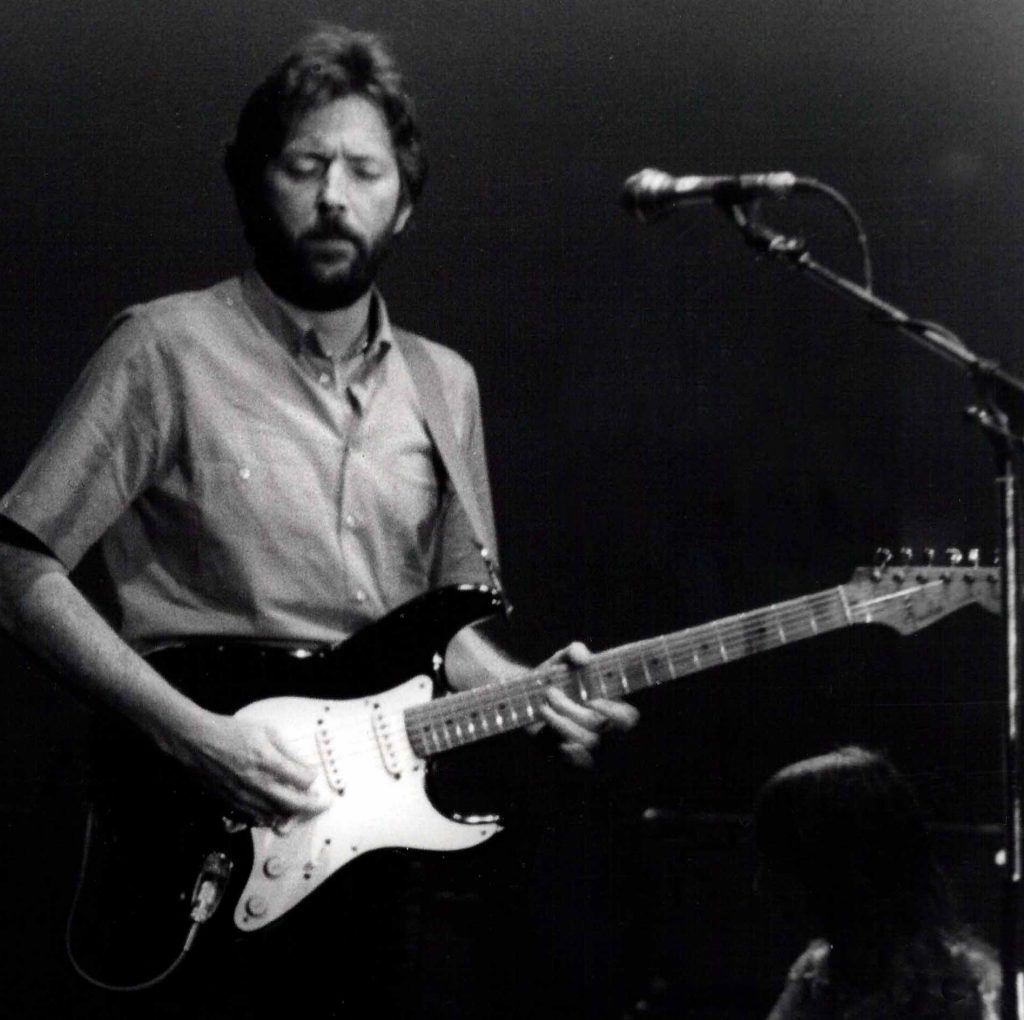
Eric Clapton, Jimi Hendrix, George Herrison, Bruce Springsteen… What’s in common to all of them besides being the greatest guitarists worldwide?
Everyone uses Fender’s guitars.
Founded in 1946 by Leo Fender, ‘Fender’ is by far the largest and most successful guitar company in the world. Their renowned ‘Stratocaster’ guitar model is most common depiction of guitars everywhere.
On the right: The famous Eric Clapton with his Stratocaster ‘Blackie’.

Even though Leo Fender didn’t use his creations himself, his impact on the music industry is insurmountable.
A regular accountant, electronics was nothing more than a hobby to him.
At first, Leo started building lap guitars- a type of steel slide guitar (as seen in the video on the right). These guitar’s success was dwarfed in comparison to his sensational bass revolution: Until the early 50’s the only bass equipment was the hulking, expensive and acoustic contrabass. Solid body bass guitars as known today, brought bass from the rhythm section to the front line by being light, commercially available and accessible.
And the revolution didn’t stop there: In this book I’ll focus on Leo’s influence on the guitar world through the Telecaster and Stratocaster.
The First Model- The Telecaster:
The first prototype of the Telecaster started as the ES guitar (short for Electric Spanish) in 1949 Which evolved into the Broadcaster the year after. Unfortunately the name ‘Broadcaster’ was already owned by Rickenbacker (another successful company) and so in 1952 Fender released the first ‘Telecaster’ model. It’s name is derived from the word ‘Television’ and it’s yellowish color was meant for TV broadcasting in B&W.
The Telecaster was the first mass produced solid body guitar and it was unique in it’s ability to be modified as the neck was screwed and not glued to the body.

Jimmy Page’s ‘Dragon’:
Page’s 1958 Blonde Tele was given to him by fellow blues-rock legend Jeff Beck. In late 1967, shortly before the formation of Led Zeppelin, Page stripped the paint off his guitar and spent an evening hand-painting an inspired psychedelic artwork on the body. ‘Dragon’ was used to record the iconic ‘Stairway To Heaven’.
Keith Richard’s ‘Micawber’:
Richards’ 50s ‘Micawber’ was gifted to him by Eric Clapton on The Stones guitarist’s 27th birthday. You’ll hear its unmistakable tone on Stones classics such as ‘Honky Tonk Women’ and ‘Brown Sugar‘. Similarly to Page’s ‘Dragon’, ‘Micawber’ has gone through several modifications.
Bruce Springsteen’s ‘The Mutt’:
The 1952 Telecaster, nicknamed ‘The Mutt’, purchased in 1973. It originally belonged to a dodgy record company throughout the 60’s. Springsteen has toured with it for close to 50 years, and ‘The Mutt’ has appeared on numerous LP and single covers.
George Harrison’s Rosewood Telecaster:
You can’t talk about popular music without mentioning The Beatles. Harrison’s Telecaster made wholly from rosewood is especially remembered from the 1969 rooftop concert.
The Go To Model – The Stratocaster:
The Stratocaster’s model is the first association that comes to mind when talking about guitars.
Following the Telecaster’s success, the new innovative model possessed a lighter body and a stylish double-cut design.
From Funk to Heavy Metal, the versatile Stratocaster can serve your every need.
First built in 1954 only by the hundreds, the Stratocaster has rapidly gained recognition- by the late 50’s every musician was familiar with it.
Since its first release the model has virtually stayed the same to this day.
Buddy Holly at Ed Sullivan’s Show:
Holly was perhaps the most influential Stratocaster player of the 50’s rock and roll.
It must be mentioned that Holly was one of the first artists to bring the Fender Stratocaster into the mainstream, and his sunburst Strat became as iconic as his black-rimmed glasses.
Eric Clapton’s ‘Blackie’ & ‘Brownie’:
‘Blackie’, a mix of 1956 neck and 1957 body models has served Clapton onstage and in the studio for many years.
Let’s not forget ‘Brownie’ either- a two-tone sunburst Strat which was his first. It appears on Derek and the Dominos’ classic ‘Layla’.
‘It just came alive as soon as I played it on that ’61 Strat’
Mark Knopfler on ‘Sultans Of Swing’.
Jimi Hendrix’s Woodstock Strat:
This is probably Jimi’s best-known guitar. It was used at the Woodstock Festival on August 18, 1969. As a lefty, Hendrix flipped his right-handed guitars over. Today it is kept safe at the Museum of Pop Culture in Seattle.
Stevie Ray Vaughan’s ‘Number One’:
His favorite Stratocaster, dubbed ‘Number One’, was a hybrid guitar that boasted a ravaged 1963 body and a 1962 rosewood neck. It also featured a left-handed tremolo in honor of Jimi Hendrix.
David Gilmour’s ‘#0001’ Stratocaster:
Gilmour’s white Stratocaster adorning the serial number #0001 is one of the first hundreds of Stratocasters ever made.
Gilmour used it on ‘The Wall’, most famously in the funky rhythm part of ‘Another Brick in the Wall (Part 2)’.
Apparently, the guitar had originally belonged to Leo Fender who gave it to Seymour Duncan (a famous guitar parts manufacturer). Duncan later sold it in the mid 70’s for $900.
Finally, last year this model was sold for $1,815,000!
George Harrison ‘Rocky’:
Greoge Harrison and John Lennon got matching Sonic Blue Strats in 1965. Harrison played his on The Beatles albums: ‘Help!’ (1965), ‘Rubber Soul’ (1965) and ‘Revolver’ (1966). In 1967 it had gone through a multicolor psychedelic makeover by his wife. It thereafter appeared on ‘Sgt. Pepper’s Lonely Hearts Club Band’ (1967), ‘Magical Mystery Tour’ (1968) and on Harrison’s solo efforts, by which time it acquired the nickname ‘Rocky’.
Conclusions And Personal Takes:
The sound of Fender guitars defines the sound of popular music and popular songs are played by them since the 50’s.
The fact that Fender turned guitars into a commercially available, mass produced product has made it possible even to the average guitarist to enjoy a high standard electric guitar.
My motive for writing this E-Book is the fact that I’m a proud owner of a Fender’s guitar myself and I find it’s rich history incredibly fascinating.

Published: Nov 11, 2020
Latest Revision: Nov 11, 2020
Ourboox Unique Identifier: OB-932621
Copyright © 2020








